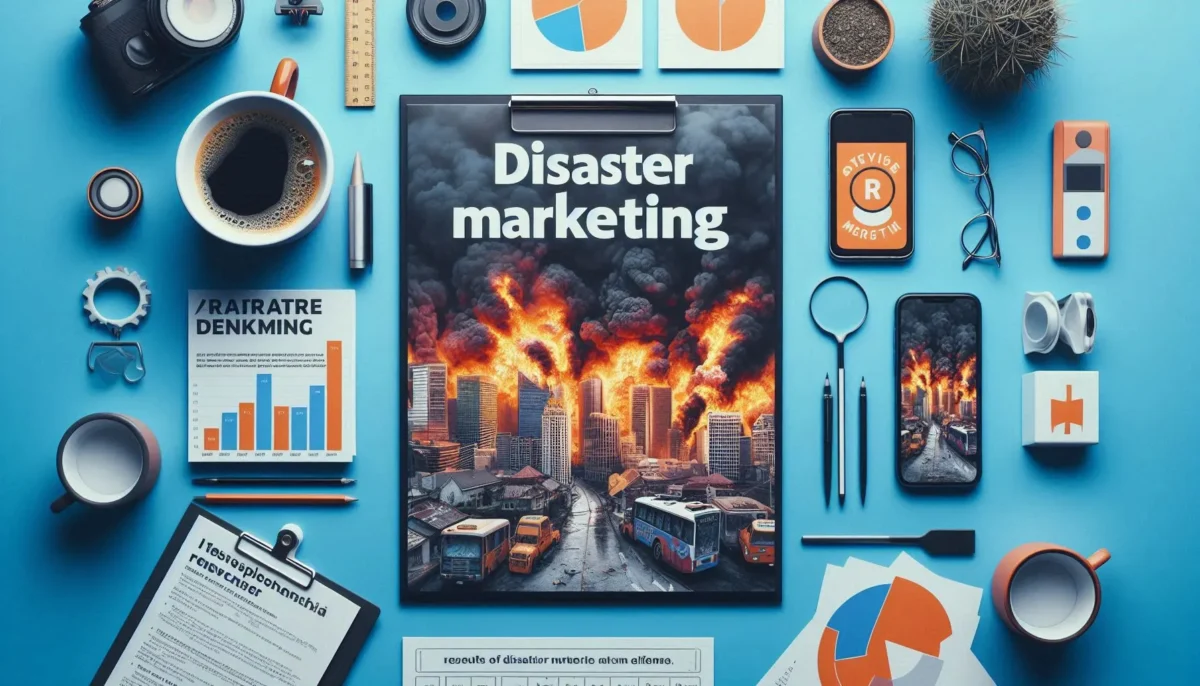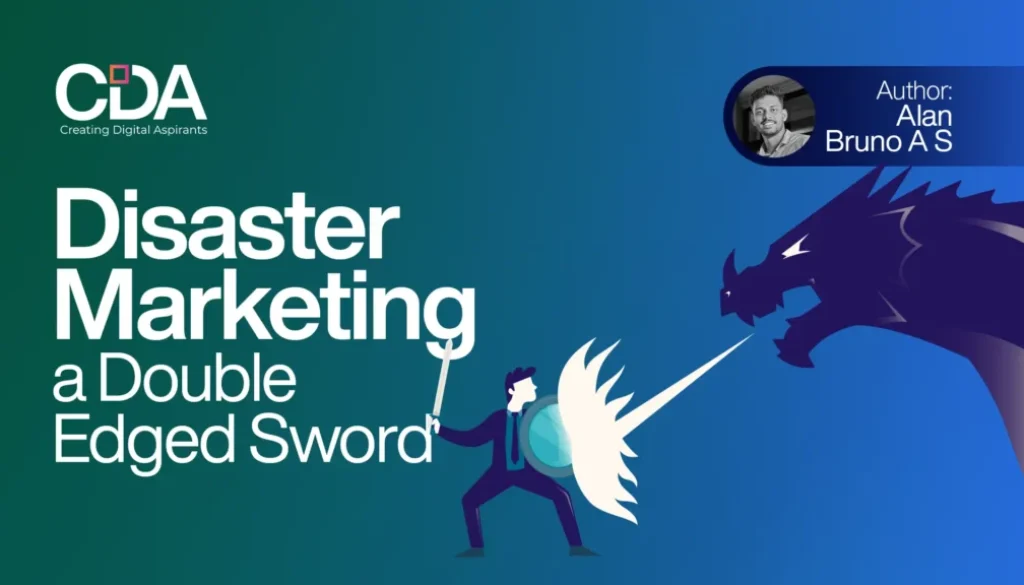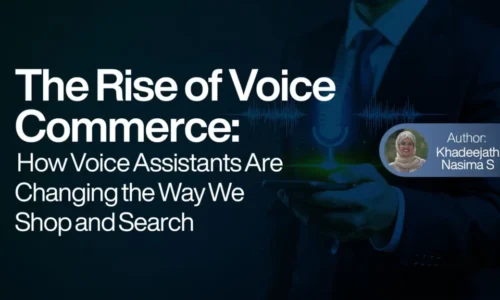Disaster Marketing a Double Edged Sword
In digital marketing, where creativity and strategy were thought to meet, comes yet another contrarian concept: disaster marketing. It involves timing marketing efforts around major disasters or crises. While some businesses genuinely try to render help and support, others face accusations of opportunism or insensitivity. This is where disaster marketing can really be called a double-edged sword, which could either gain really valuable goodwill for the brand or totally harm its image.
Disaster marketing is not bad per se. Sometimes, it is a useful and sorely needed way to mobilize funds and support during a disaster. If conducted with the right motives, it speaks well of a brand’s social responsibility, providing supportive campaigns for the programs of relief agencies which help alleviate the pain of a disaster. If conducted badly, however, or as a result of an ulterior motive for profit, it assuredly will raise the ire of the public and cause serious, long-lasting damage to a brand’s image.
Table of Contents

Case Studies: A Mixed Bag
Results of disaster marketing can range from markedly positive to extremely negative. Let’s consider some of the most interesting case studies and find out how different brands treated this sensitive topic and what kind of consequences they faced:
- American Red Cross and the 2010 Haiti Earthquake
An outstanding example of how disaster marketing worked. The American Red Cross was quite successful at raising millions of dollars in aid through a properly planned social media campaign. They made it very easy for them to give through SMS donations and gathered over $32 million in just a few days. The campaign received wonderful reviews for effectiveness and transparency in its mechanism, proving that during disasters, a well-planned marketing strategy will deliver real value.
- PepsiCo’s Response to Katrina
The second remarkable conduct was that of PepsiCo which provided disaster-related supplies and launched campaigns highlighting their efforts in every form. It has collaborated with the American Red Cross and contributed more than $1 million in aid, along with water and food supplies in enormous quantities. Their focus on the element of sheer assistance, rather than just screaming and boasting of their brand image, enabled them to enhance their image as socially responsible concern.
- Patagonia’s Commitment to Environmental Stewardship
The decision of Patagonia to donate 100% of its online sales to the recovery organizations involved in the 2017 California wildfires was both proactive and an act of sincerity. Messaging has been clear and on point with long-standing commitments to environmental causes, further building out the reputation of this values-over-profits brand.
- Uber’s Timely Assistance in Nepal
The fact that Uber provided free rides to relief workers and medical personnel during the 2015 Nepal earthquake was a genuine affair to assist needy people. In that critical period, giving them essential transportation was a definite positive for the relief effort without directly advertising the services of Uber. In such a subtle but effective manner, the company is able to gain goodwill without appearing opportunistic.
India: A Country in Balancing Act
India has equally had its fair share of disaster marketing campaigns. A few have gained praise for humanitarian acts, while others, though perceived as opportunistic, have attracted criticism. The cultural context and the peculiar challenges thrown up by every disaster make for immense variation in this perception.
- Amazon-Relief Efforts
During the Kerala floods in 2018, the campaign by Amazon India worked much on relief and was indeed widely appreciated for its genuine intent and effective mobilization of resources. By creating a dedicated relief page and engaging with NGOs, Amazon helped facilitate customer donations of essential items to the affected people. In this way, the campaign was termed as the positive use of its logistics capabilities for disaster relief.
- The Wholesome Support from ITC
The interventions related to relief by ITC during Cyclone Fani reflected a sense of responsibility in prioritizing support over promotional returns. Food and other consumables were provided in the affected areas, not necessarily over-branded, striking a fine balance between support extended and visibility for the brand. And, perhaps more importantly, subtlety worked here, like so many other instances in disaster marketing.
- Airtel’s Immediate Help
During the Chennai floods in 2015, Airtel provided free talk time and data to its customers on the network-a social cause well-appreciated by one and all. Besides helping a lot of customers tide over the disaster, the brand seems to have gained immensely in terms of reiterating its customer-first image.
- Mobilization of Resources by HDFC Bank
The mobilization of funds and relief by HDFC Bank in the Uttarakhand floods in 2013 fully utilized its banking network for the contribution to disaster relief. The bank enabled donations through branches and online platforms, ensuring transparency and accountability in the deployment of the funds. The campaign brought into light the dire necessity of tapping into networks and capabilities for disaster response.
The Dangers of Opportunism
There is, however, a thin line separating genuine support from opportunistic exploitation. A few brands in India drew flak during the 2018 Kerala floods over disaster marketing efforts and attendant risks of this strategy:
- Snapdeal’s Promotional Offer
As part of a promotion it was running during its campaign on disaster-relief-related products, Snapdeal was perceived as insensitive to the people and exploitative in their desperation. While this may have been an attempt to encourage donations, offering a promotion surrounding a disaster was definitely tone-deaf and sparked backlash and negative publicity.
- Discount Offers by Zomato
When the city was faced with floods, the move by Zomato to promote its service at discounts had drawn strong criticism as an attempt to push sales rather than a genuine concern to make some contribution towards the relief work. Again, this underlines the need to get a feel of the pulse of public sentiments to avoid every action that smacks of opportunism.
- Urban Ladder Marketing Campaign
The marketing campaign of Urban Ladder, which included a call-to-action pertaining to the disaster, came off as inappropriate and exploitative. Certainly, no company wanted to use the tragedy as a backdrop for a promotion. Several criticisms were showered on the company for using the tragic event as a premise for promotion. This underlined sensitivities and careful consideration that need to be thought over when disaster marketing is used.
Ethical Considerations for Digital Marketers
In running the minefield of disaster marketing as a digital marketer, the following might be just some valuable ethical considerations to note so as to avoid any missteps and make sure their efforts are viewed as positive in nature:
- Prioritize Real Support
Make sure the marketing is actually contributing to the relief efforts, not using disasters as an opportunity to take advantage of a bad situation for their gain. It can be in the form of partial proceeds, offering much-needed resources, or even just providing your platform to help drive awareness and donations to better organizations.
- Show Empathy towards Affected Communities
Understand the traumatic experiences that local people have undergone and approach the subject with empathy, showing your respect. That is, avoid anything that sounds insensitive, including language or imagery that might be perceived as such, and frame messaging toward support and in-solidarity messages rather than sales.
- Avoid Exploitative Tactics
Never use disasters as a prop to stage marketing activities that might be considered insensitive or exploitative in nature. This includes refraining from using the “sale for a cause” type of expressions or using disaster imagery in advertisements. Instead, speak to how your brand can genuinely help those in need without overtly seeking to profit from the situation.
- Accountability and Transparency
Be transparent about your organization’s involvement in either local or wider relief efforts. Account for the funds involved or resources invested. This perhaps may mean periodic reporting on how donations are spent, or actually working hand in hand with other organizations able to guarantee such resources reach their intended target.
- Be Sensitive to Cultural Sensitivities
Every community suffers from disasters differently, and what might be appropriate in one culture may be viewed as insensitive in another. Take the time to understand the cultural context and sensitivities of the affected area before launching a campaign. Consult with local organizations or community leaders to learn and understand how you can be respectful and relevant in your efforts.
- Leverage Your Strengths
First and foremost, know what your company does well and how to position that in service of relief. This may include providing transportation if your company is a logistics company or providing communication devices if it is a technology company. This alignment of disaster response to your core competencies creates an opportunity for you to provide relevant assistance while maintaining fidelity to your brand values.
- Prepare in Advance
Rather than reacting to disasters as they occur, you might consider developing a disaster response plan in advance. This can include how your company will respond to each type of disaster, what kinds of support you’ll be able to give, and what partnerships you will make. A plan like this can help make sure a more thoughtful and effective response when disaster strikes.
Conclusion
Disaster marketing opens a very tricky paradigm for a digital marketer. While this may be an effective way to galvanize support and resources, a very fine line needs to be drawn between the genuine humanitarian effort and being ethical in consideration. The brands which pull that off are the ones showing empathy, being transparent, and actually support the cause, proving social responsibility is not taken as an opportunity.
This is where, at a time when the world is haunted by natural disasters, pandemics, and such other crises, digital marketers continue to be vital players in shaping people’s perceptions and driving positive action. By adhering to ethical guidelines and chalking out meaningful contributions, marketers can assist in bringing about a change with their abilities and platforms for mitigating suffering and recovering from a crisis.
Eventually, disaster marketing is not just about immediate crisis response; it is actually about relationship building and long-term trust with consumers. If done well, it reinforces values a brand carries, strengthening its reputation as socially responsible. Done poorly, it results in backlash and possibly even damage that may take years to repair. It is finding that fine line between being truly supportive and opportunistic, and always taking that route of empathy and integrity.
Author Info
Alan Bruno, A Digital marketing expert in Kochi
Learner of CDA Digital Marketing Institute Kochi



